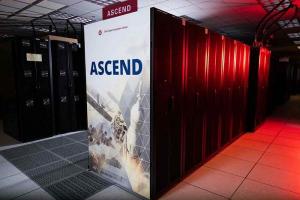The Ohio Supercomputer Center (OSC) will offer expanded high performance computing (HPC) resources on its Ascend cluster in early 2025, in collaboration with The Ohio State University Wexner Medical Center and The Ohio State University College of Medicine.
Ohio State Wexner Medical Center has transferred ownership of a research computing cluster to OSC, which will increase by six times the HPC power of Ascend’s current configuration for all of OSC’s academic and commercial clients.
“OSC has a strong relationship with the Ohio State College of Medicine, and over the last decade we have provided dedicated resources to support the work of its faculty and staff,” said Douglas Johnson, associate director of OSC. “When the college approached OSC about the opportunity to leverage their hardware for research computing, we knew we had to find a way to make it happen. The addition of such a large resource will bring monumental benefits to both Ohio State and the rest of our client community.”
With the enhanced Ascend resources, all of OSC’s clients, including faculty and staff at Ohio State Wexner Medical Center and College of Medicine, will access more powerful computing hardware, benefit from shorter wait times and can streamline their workflows in one environment. The revamped cluster will help train the next generation of medical researchers and help further medical research at Ohio State.

“The ability for the Ohio State College of Medicine and OSC to collaboratively expand our data analysis capabilities is a win for the biomedical community and advances our mission to transform medical education, research and patient care,” said Carol R. Bradford, dean of the Ohio State College of Medicine.
“The Ohio State College of Medicine-OSC relationship expands the capacity of the existing Ascend cluster by a factor of six to seven, and it puts the day-to-day management of the hardware in the hands of the subject matter experts best positioned to help us leverage the investment effectively,” said Timothy R. Huerta, chief research information officer at the Ohio State College of Medicine. “This approach is the most cost-effective one for the stewardship of our resources in support of our shared discovery mission.”
The additional graphics processing units (GPUs) on the Ascend cluster also will help accommodate the growing number of OSC clients using the HPC clusters for artificial intelligence and machine learning work.
“OSC’s recent system upgrades have focused on providing new and advanced high performance computing resources that can handle the intensive workloads associated with artificial intelligence, machine learning and data analytics research,” Johnson said. “We are seeing demand from a wide range of academic disciplines, from medicine and engineering to social sciences and the arts.”
The next-generation version of Ascend, which will be a ~14 PetaFLOP system, will feature an additional 274 Dell nodes each with:
- Two AMD EPYC 7H12 2.60GHz, 64 cores each, 128 cores per server
- Two NVIDIA Ampere A100, PCIe, 250W, 40GB GPUs
-
HDR100 Infiniband
The Ohio State cluster, which has been located at a facility in Cleveland, features $8 million in hardware that is compatible with the current Ascend cluster, which launched in late 2022. OSC is investing over $1 million to move the equipment to its data center at the State of Ohio Computer Center in Columbus and integrate it with the Ascend cluster. The next-generation system is projected to go fully online in early 2025.
OSC is overseeing the next-generation Ascend project at the same time it is completing another major addition to its data center, the Cardinal cluster, which is slated to launch in early November. Cardinal, a Dell Technologies-based cluster, is designed to support the growing need for HPC resources in Ohio for research, education and industry innovation, particularly in the area of artificial intelligence.

As OSC brings the two clusters online over the next several months, it will work closely with clients to transition them to the new resources. Cardinal will replace the Owens cluster, which has been in operation since 2016, this fall. In addition, the enhanced Ascend cluster will allow OSC to migrate some users of the Pitzer cluster, which has been in operation since 2018, to the advanced resources.
“We will be sharing more details with the community in the coming months, but there will be a gradual retirement of Owens allowing for a measured move of workload to the new resources,” said Brian Guilfoos, HPC client services manager for OSC. “The new Ascend will be configured like our existing clusters, which will make migration easier. OSC will identify clients with unique needs and help them migrate projects and workflows.”
In addition to direct client communications, OSC will host a community briefing on the evolution of its HPC clusters this fall. For more information, visit www.osc.edu.
The Ohio Supercomputer Center (OSC) addresses the rising computational demands of academic and industrial research communities by providing a robust shared infrastructure and proven expertise in advanced modeling, simulation and analysis. OSC empowers scientists with the services essential to making extraordinary discoveries and innovations, partners with businesses and industry to leverage computational science as a competitive force in the global knowledge economy and leads efforts to equip the workforce with the key technology skills required for 21st century jobs.